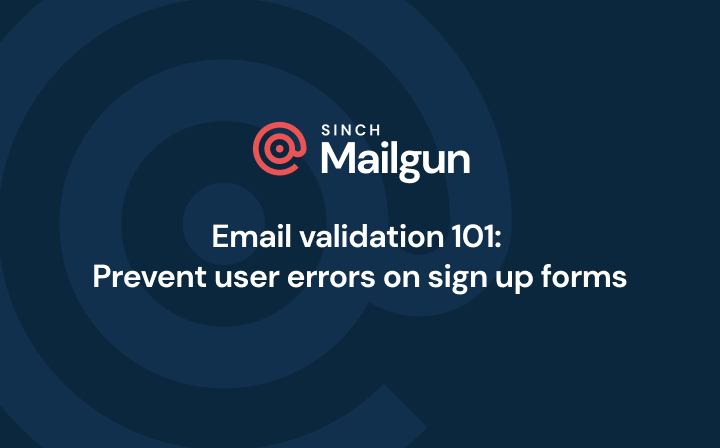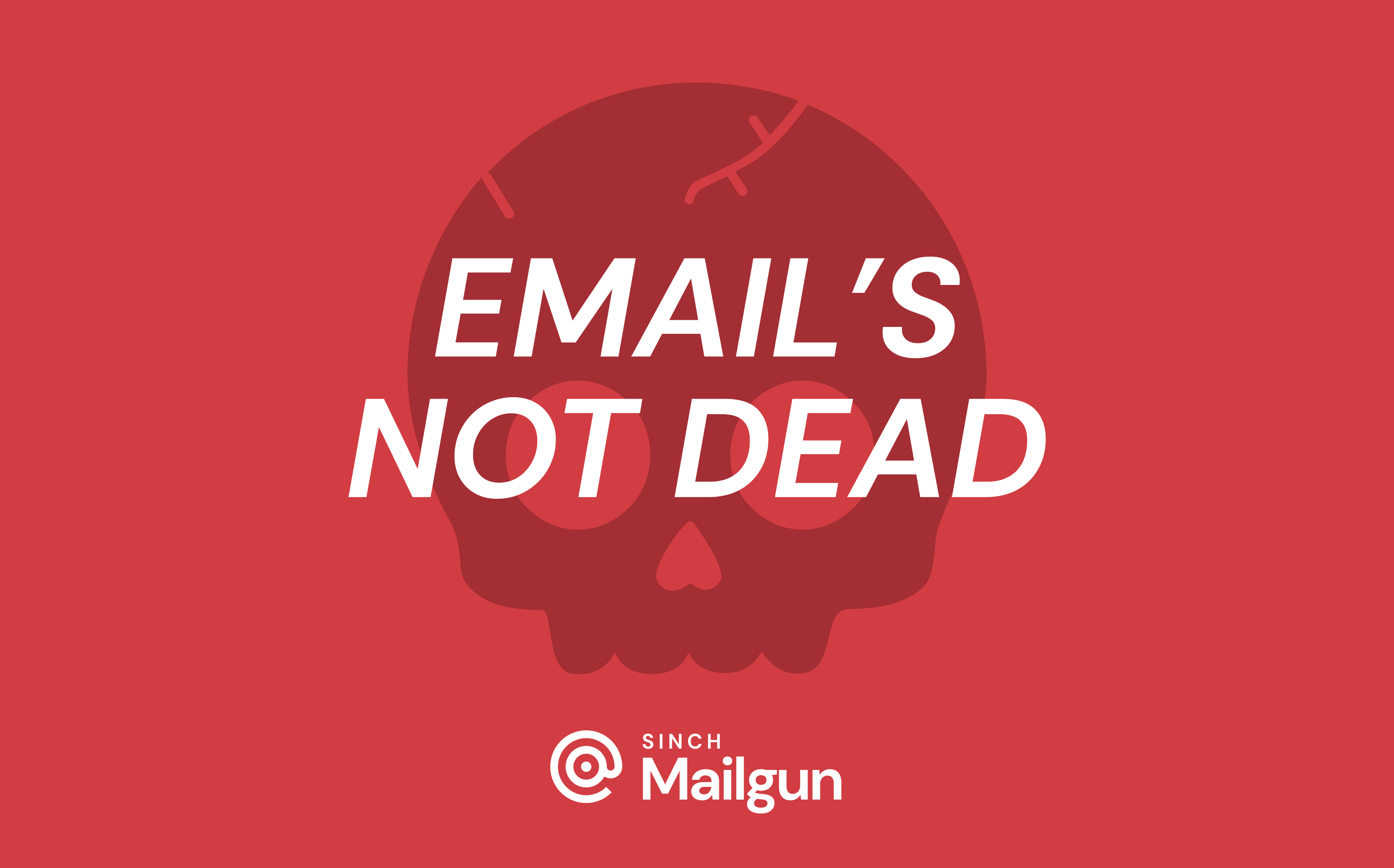Podcasts
Introducing Inbox Placement
Email’s Not Dead: Season 2, Episode 1
Introducing Inbox Placement
Email's Not Dead
About this episode:
A new year means a new season of Mailgun's Email's Not Dead. We have Jorge Miramontes, our Product Manager, introducing our newest tool, Inbox Placement. Tune in with Jonathan and Eric in 2020 to remember... Email's Not Dead!
PUBLISHED ON
Meet your presenters

Jonathan Torres
Technical Account Manager, Manager at Sinch Mailgun

Eric Trinidad
Enterprise Technical Account Manager at Sinch Mailgun

Jorge Miramontes
Sr. Product Manager at Sinch Mailgun
transcript
Email’s Not Dead – S2, E1: Introducing Inbox Placement
Overview
00:00:36 - Meet Jorge Miramontes, Mailgun's Product Manager
00:01:04 - Introducing Inbox Placement
00:00:05
Eric Trinidad: Welcome back to Email’s Not Dead. My name is Eric and this is Jonathan.
00:00:08
Jonathan Torres: Hello.
00:00:09
Eric Trinidad: We are your earbuds for all things email. Thank you for coming back. We're back with season two. Back in black. Back in action. We got our groove back. All of it. All of it. We're here again. And this year, we have exciting news in the first quarter of 2020 here at Mailgun. Looks like there's going to be a couple of new products that are coming out. And today we're going to be talking about a huge one that we're super excited for. Inbox Placement.
00:00:33
Jonathan Torres: Yes. Yes. It feels like it's been a long time coming.
00:00:36
Eric Trinidad: So we have another... your buddy joining us today, one of the product managers, Jorge Miramontes. Is that right?
00:00:43
Jorge Miramontes: Jorge Miramontes, yeah that's it.
00:00:45
Eric Trinidad: Nailed it my tongue can never do that.
00:00:47
Jonathan Torres: First try.
00:00:47
Jorge Miramontes: It's a tongue twister for sure, but, thanks for having me here, guys. I'm excited to talk about what we've been up to with our Inbox Placement product.
00:00:55
Eric Trinidad: Yeah, we're stoked, man. So can you tell us a little bit about, like, just kind of like what, what is Inbox Placement? Like, what is it and how does it work.
00:01:04
Jorge Miramontes: Sure thing. Yeah. So Inbox Placement. It's been in beta for a few months now, but yeah we're, we're launching it here in Q1, and Inbox Placement is a tool that we've created to help our customers understand where they're getting placed within a specific mailbox. So a lot of people understand what delivery is. Did you get accepted by a mailbox? But what a lot of people don't know is that you can actually be delivered and go straight to the spam folder. And so with Inbox Placement, it's a tool that we've created that provides you insights into whether or not you're getting placed in the inbox folder, in the spam folder, or you know, missed altogether. And it's a great tool for customers to use to get that extra insight.
00:01:47
Eric Trinidad: That's awesome. Well, we were super excited about it. First tool that's going to be dropped this year. We have another one coming out. We're going to talk about that in our next episode. So please stay tuned. But yeah.
00:01:56
Jonathan Torres: Really. And I know kind of one of the things that we've talked about because we mentioned the word already, so delivery versus deliverability, just so people know what the definition is. Right. Delivery is just kind of getting it there. Right. It's a matter of, you know, whatever ESP you are using whether they're using Mailgun or anything else, you know, getting the mail out of that service and into another service. That's just delivery. Right. We're making sure it's not bouncing anywhere. It's not getting dropped anywhere. There isn't anything funky going on. It's the matter of getting the mail to where it's supposed to be. And deliverability is getting it to a place where people are going to be actually able to see that message. And for most providers, that's going to mean the inbox. Gmail is the one unique one that kind of has there, that are tabbed view, which is a little bit more unique to them. But it's helpful, I think, for most people whenever you start looking and using it the right way. But it is one of those nice features that they have that is useful that they do also consider part of the inbox. So it definitely does have those two definitions. Right. So like getting into the inbox, but someplace really that is visible to the customer that you're trying to reach or the business person, you're trying... or whatever it is that you're trying to, trying to do on that end of things. But it is definitely hitting that location that they can see it.
00:03:03
Eric Trinidad: Yeah, making sure it's getting to the front door. We're just not chucking it over the fence, you know.
00:03:07
Jorge Miramontes: Definitely. And yeah, people might be wondering, well, how does this actually work? What is the technology underneath the hood for Inbox Placement? So I'll briefly touch on that. So we're using something called seed testing, passive seed testing. What we do here at Mailgun with this product is we went out and we created a bunch of mailboxes at all the different providers. And what we do is that we get you to provide us a subject, a body for an email that you want to test. You send it out and we go ahead and do the hard work of connecting to all those mailboxes to understand where you're actually getting placed. And we return those results to you and we give you a nice aggregated view, a mailbox provider view and extra information so that you can make the decisions that you need to make.
00:03:45
Eric Trinidad: Right on.
00:03:46
Jonathan Torres: So, so along with that. Kind of outline some stuff to talk about and some talking points. It's going to be a little bit outside of that. So forgive me, first of all.
00:03:55
Eric Trinidad: All ready, wild card.
00:03:58
Jonathan Torres: Like one of the things that I guess would be kind of important to understand, what is the difference between the Inbox Placement tool and how that can be used and utilized compared to when I just send my emails normally and get, you know, my results back for what it is. Right. Like, I... every day I send out messages, every day I get results back of how many people open my messages, how many people actually interact with my messages through click tracking and open tracking and things like that. Like, what is the benefit of having this tool over that and how does it work differently when we compare it to those two things?
00:04:27
Jorge Miramontes: Yeah, so I think that's that's a good question. One thing that I'd like to take a step back here and explain is this concept that we call here the sending funnel. And I think this will help illustrate where Inbox Placement kind of helps in that regard. So if you think about sending email, let's say you send out one hundred emails. Ideally, in a theoretically perfect world, you would have one hundred those emails clicked on, engaged with. Now, we all know that the reality is not that it's far from that, but we try here at Mailgun to make that as close as possible. And in the sending funnel, there's several steps. The first step is, sending the actual email, so that's something that you can do with our APIs via SMTP, we have that ability today. The second step, you need to get delivered, and that's really important. And a lot of times you might get hard or soft bounced. Let's say you have some bad emails. So, for example, we have our validations product that allows you to go in and actually validate emails so that we can reduce that and get an increase in delivery rate. Now, the next step after that is where Inbox Placement comes in. And this is where we talked about earlier on delivery versus deliverability. The next step in the funnel is deliverability, already placed within the mailbox. And you have been delivered. And then next episode we're going to talk about STO. But after you've been delivered and you've been put in the inbox folder, how do you actually get engaged with, how do you get an increase in open rates and increasing click rates? And that completes the funnel. And so that's where Inbox Placement fits in. And here, Mailgun again, we're excited this quarter because we're launching all these products to really widen the aperture towards the bottom of the funnel so that you can get as close to one hundred of those emails engaged with at the end of the day.
00:06:02
Eric Trinidad: So what we're trying to get to is like a sending cylinder.
00:06:04
Jorge Miramontes: There you go, that's a good visual. That's a perfect visual.
00:06:09
Jonathan Torres: So if I'm using this right. Like does this, going to help me guarantee, like, I might be able to use this tool to kind of guarantee the fact that if I do send something, that it's going to get there, one, have good delivery and then deliverability like is that something that's going to help me completely complete that cycle to get me to one hundred percent? Or what is the reality of using this tool? And then how am I using it to make sure that I can get as close to a hundred percent as possible?
00:06:32
Jorge Miramontes: And like I said, there's a lot of different factors, right, in the sending funnel that you have to account for, Inbox Placement, just like a lot of tools out in the market, is not a silver bullet. So you want to keep that in mind? But it does help move the needle in the right direction, right? If you're not focused on deliverability at all, you can be delivered straight to the spam folder one hundred percent of the time. And you wouldn't know it other than maybe perhaps through your open and click rates. Right. Those were also zero. So really, it's this collective effort using all the tools at your disposal to understand really where you're getting placed and to increase that ability for you to actually get delivered and ultimately really engaged with is what you want.
00:07:09
Jonathan Torres: Yeah. I mean, engagement is important. We've talked about that, I think a lot in the past. If you haven't listened to those episodes, season one, go out, listen to it right now. But that's a big part of the game, right? Like whenever we're talking about making sure that we have a good reputation, that ISPs are looking at us favorably because we are sending good email. And I think that's the goal of all of us, is to send good email and to send things that are relevant to people and that people want. So whenever we're missing out on engagement, that is super important to us and to, I think, everybody within the email sending community. We need to make sure that those emails are actually engaged with. But when there's things that we can't see behind the scenes, I mean, if you are going to spam folder or something bad content wise within your message, like that is definitely a hindrance. And hopefully that's not the things that are happening. Hopefully that it is that, you know, one, we have the right set up for our emails in place so that we are completely eliminating the possibility of that. And then two, that we have a good reputation and good standing with the ISPs that we're sending to, because that is going to be another big piece to getting good delivery and deliverability. So there's definitely a lot of factors that kind of come into play. But I can definitely see how this can help start widening that scope and see what other possibilities are, is what ISPs we're missing on. I think essentially two is going to be part of the toolset, right? Like what? Not only, you know, in general, like how many are going to the inbox or spam folder, but then breaking it down by different ISPs, correct?
00:08:34
Jorge Miramontes: Correct. Yeah, that's important. And again, that's one of the things that we focused on with this product, is providing you with the right level of granularity to understand where you're having problems at. So, yeah, we do have a mailbox provider view and that allows you to dig into specific mailbox issues. I do want to point out we do have tab placement for Gmail as well. That is kind of the special provider out there. Yeah, quick note on that. A lot of people think that the tabs aren't part of the inbox. Those are all actually in fact part of the inbox. So I want to highlight that a lot of people think the primary tab is the inbox folder and everything else are just spam type folders. No, that's not it. There's actually a dedicated spam folder and then you have all your inbox tabs, right? So, yeah, we also have that. But as we move forward with the product, yeah, we hope to provide you as much insight as possible into the individual providers out there.
00:09:24
Eric Trinidad: That's awesome. And guess you know why now, like what's coming out now, like this is another great tool. You know, we have some tools that are coming out later on in the year to kind of help us. Kind of widen that aperture, as you were talking about. But what about like, what are other tools that are similar that are currently out there? And how is this different compared to that?
00:09:42
Jorge Miramontes: Yeah, there's other tools, Inbox Placement. Again, it's, it's been out in the market for quite a while, but there's a key difference. Those providers don't actually send email, whereas here at Mailgun we do. And I think that puts us in a unique position to offer this product. There are some specific integrations that we're able to do that allows us to really be a one stop shop and not have to go to multiple providers to get the results that you need. And so here at Mailgun, what we've done is that we've built it into our product and it's integrated with our email sending pipeline. So, for example, when we send out our seed test that is directly integrated with our login and analytics and another cool feature that we have upcoming is predictive placement based on various algorithms. One of the algorithms that we're excited about is being able to use your historical sending domain history to actually predict your Inbox Placement results with the finer scope. We could also have predictive placement by mailing lists. Again, the point here is that as a sender of emails and ESP, we'll be able to integrate this much more closely to the rest of the product set and have a more collective, unified experience for the user.
00:10:47
Jonathan Torres: It's nice to be able to use tools that are all together in one place. And I know with everything else that's coming along the lines, with the fact that we have a little bit of collective knowledge of how to send and what we're sending and, you know, doing a lot of these things that are basically going to help set things up in one home. I know. Part of the other thing that was talked about with the Inbox Placement feature, specifically if you're using it at Mailgun with the product, and if you're already sending with Mailgun as your ESP, then part of the toolset was going to be sending from the IP addresses that you have already on your account, correct?
00:11:20
Jorge Miramontes: Correct. Yeah. So that's, that's one of the things that you can benefit from here. Again, part of that user experience that's really streamlined, it's really easy to actually go through an Inbox Placement test here at Mailgun. Really all we need from you when you're sending in a test here at Mailgun is a sending domain, which we actually provide that for you easily to just click on it. You just select it and then provide us a subject and provide us a message. Those are the three things that you need to do. Now with other providers, you need to actually go figure out where you want to send from. You've got to also do the subject of the message, but you also have to copy a seed list from the provider, go to your ESP of choice and put that information and send it and then go back to the provider that's providing the Inbox Placement testing and then wait for the results to come in. And so a little bit more complicated. A process, a little bit hairy here, streamlined to just really three easy things that you have to provide.
00:12:16
Jonathan Torres: Yeah, that's awesome. That is really cool. Yeah. And I know in my time I've done seed testing testing with certain lists and with other providers and it's not terrible doing that kind of stuff. But it is, like you said, time consuming and, you know, a little bit cumbersome. And if you miss some, you know, then you've kind of shot yourself in the foot with the integrity of that test and what that could have been. So I like that it's taking steps outside. It just creates so much less human error possibility, which is super nice all the time. With that along those lines, I guess, like, we have the benefit of it being in one home, in one location. What about like, the types of emails, like what kind of benefits can we get with the different, you know, things that you can test out, how you can use these tests? Like where do the benefits line that and what are the possibilities at least that you've seen in these cases so far?
00:13:01
Jorge Miramontes: Yeah, let's talk about ways to use this product. And I think you hit the head on the nail there. Right. It is a little bit of a time consuming process. You want to have this as part of your process for sending email because of the importance of deliverability. So you really want to make it as easy and as fast to use as possible. So a couple of ways to use this. One primary way to use Inbox Placement is if you're doing any marketing campaigns. One of the things I love about Inbox Placement testing is it's one of the few tools out there that we have that is actually proactive in nature. Right. So you're sending not to your recipients, you're actually sending to a seed list. And so that allows you to go and actually test some things. And with email marketing campaigns in particular, one of the strategies that you can use is an iterative strategy where you actually go send out your first draft of an email that you want to send to your recipients. You understand where you're getting placed and then you tweak it. And as you tweak it, you understand, well, how am I actually comparing almost in an A/B testing type mentality? How are you comparing over time throughout these tests? And then once you get to a point where you're getting placed, where you're okay with it, then then you're free to go send it and you have that confidence. So that's one primary use case that we see people using this product with here at Mailgun. Another really interesting use case is for transactional emails, so you may have a transactional email template, for example, that you haven't changed in years, right? It's just been working and it's a receipt, for example, if your e-commerce and it hasn't really changed. Well, one of the things that you probably won't keep tabs on is, well, what are the mailbox providers doing over time? Are they changing their algorithms such that you're starting to get placed differently? Imagine being in Gmail and you're in the primary tab and that's where you want to be. And all of a sudden, boom, one day you're in the forums tab. You're like, wait a minute. My stuff's not supposed to go there. You want to keep tabs on that. And so a really interesting use case here is to maybe on a weekly, monthly, some sort of cadence that you're comfortable with, go actually create these seed tests with those templates that you have for your transactional emails, and just keep tabs on it over time and understand are you actually changing where you're being placed? So that's another really cool use of the tool that we see. Really, both marketing emails and transactional emails can benefit from this. But yeah, no, it's... it's a pretty cool tool. It's exciting. And I think really the proactive nature about it is really what's cool.
00:15:27
Jonathan Torres: Right. Yeah. I mean, it kind of puts the control back in your hand. You know, I can't count how many times I've been asked the question, like, why is my mail going to spam? We're going to promotions, like, if this is a transactional message, it's like we haven't changed anything and it's like, cool, you haven't changed anything. That's 100 percent correct. You're not wrong. But it does it mean that everybody else isn't changing. The world adapts and the world adapts every day. And I think we've talked about that a lot, you know, and everything that we've ever talked about with an email like on this podcast and in daily conversations where every day is new, uncharted territory because somebody out there can do something crazy with one message that they hit to every single ISP that's out there. And all of a sudden, like a string of words, is going to be now messed up for everybody.
00:16:12
Jorge Miramontes: Yeah, no, it's this, this game of cat and mouse man that we see right in. The mailbox providers are trying to have a spam free world. Right. And it's just a constant battle that's evolving over time. So you need to move along with that and evolve with the times.
00:16:27
Jonathan Torres: Yeah. Oh, that's fun. It's fun to do that all the time.
00:16:30
Eric Trinidad: Absolutely. So kind of wrap it all together. A new tool, just another tool for your tool belt. Something that's going to help you just widen the aperture overall and get to that sending cylinder that we're all striving for. And here at Mailgun it's going to be easier for you to use and just give you that overall confidence just to know where your messages are going. So I guess with that, you know, if you want to learn more information, we're going to have a blog post and some more information coming out on our website. Please let us know if you do have any questions, concerns. We'd love to hear your feedback. Jorge, have you heard so far as, like, from our customers?
00:17:03
Jorge Miramontes: We're just getting out of beta here today and moving into general availability, and the feedback has been positive. Everyone that's been using this has definitely seen the power of the tool and has been surprised actually to see that they're not getting placed where they expected to get placed. So, yeah, use this tool starting today and understand where you're getting placed and increase that engagement.
00:17:25
Jonathan Torres: I think the next time we definitely want to talk about one of the other sets that I think the tools are, again, coming back and wrapping up to everything, coming back to you, making sure you have good engagement. We're following best practices whenever we're doing anything, and that includes who we're sending to, how often we're sending to them, and then what that visual looks like. You know, once the message gets there, one of the things that we do want to make sure is we're optimizing engagement points. And so that's going to be kind of the next subject that we want to talk about with our Send Time Optimization. That's coming out real soon also. Are they dropping the same day?
00:17:55
Jorge Miramontes: Yeah, they're actually dropping the same day. So we're hitting that funnel hard in one day. Again, it's the collection of these tools. So, yeah, I'm excited for that episode. I'll be tuning in as well to listen in with my counterpart, Chris Farmer, on that.
00:18:10
Jonathan Torres: Yeah!
00:18:11
Eric Trinidad: Well until next time, we'll talk to y'all later.






